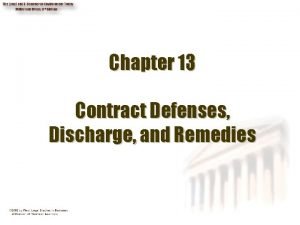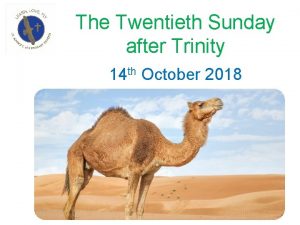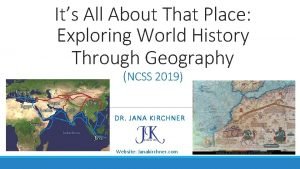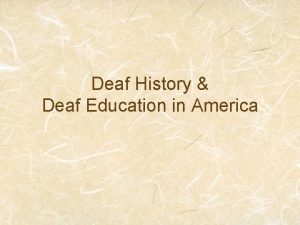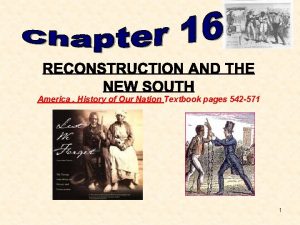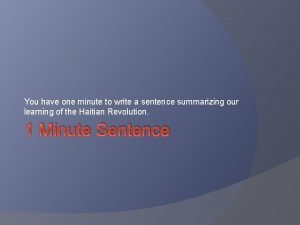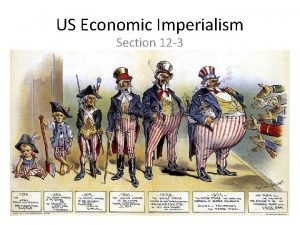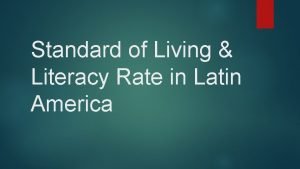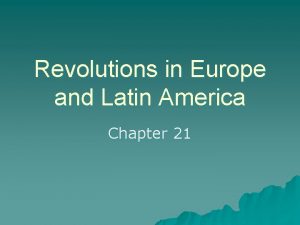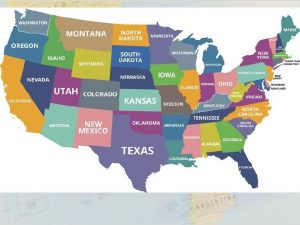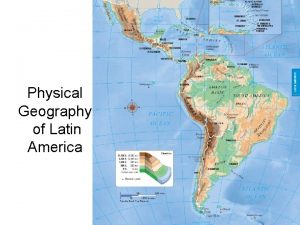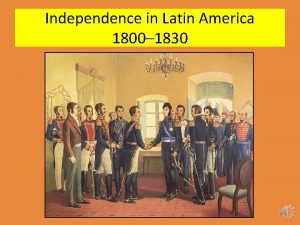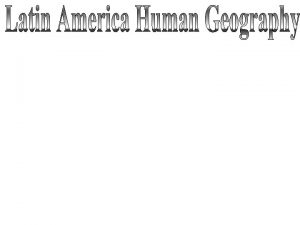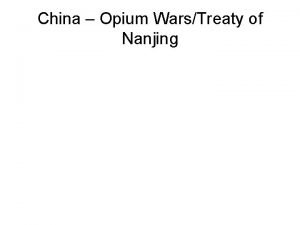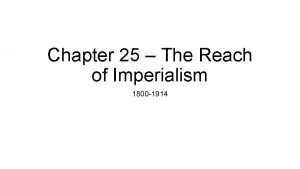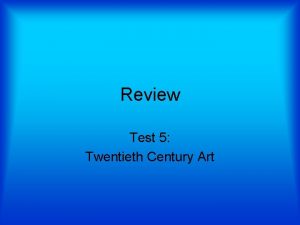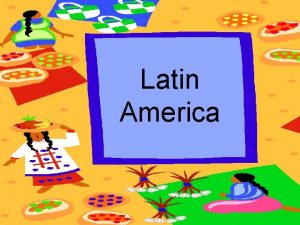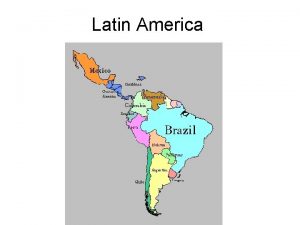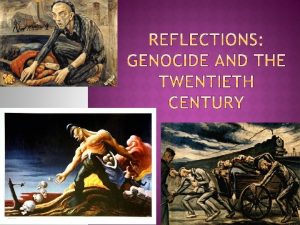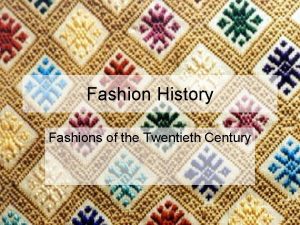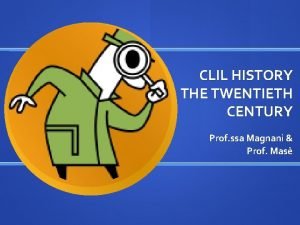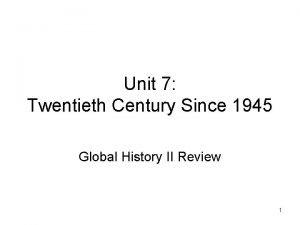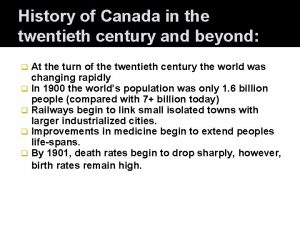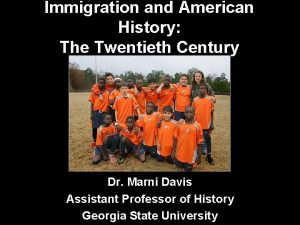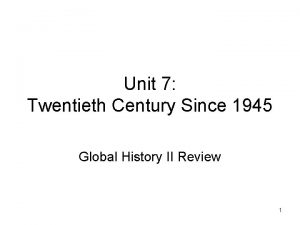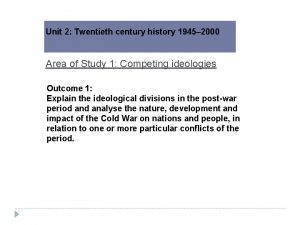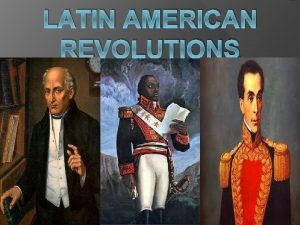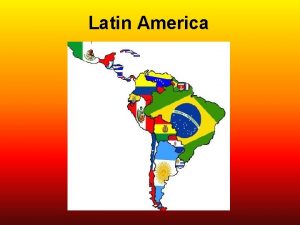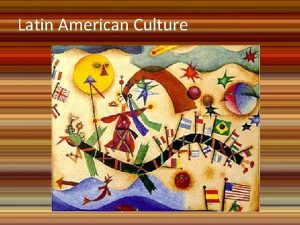Exploring Twentieth Century Latin America History of Latin

























- Slides: 25

Exploring Twentieth Century Latin America

History of Latin America The political struggles of this region include: 1. 2. 3. 4. colonial domination military rule death squads and changing spheres of influence.

Government Changes n n During the 1980’s, Latin America suffered through ten years of economic decline, war and political instability. By the 1990’s-some countries began changing to a Democratic form of government. Dictatorships fell and free-market economies began to take hold in many Latin American countries. Political corruption and poverty remain.

Economic Gains n n n Economics- is defined as the production, distribution, and consumption of goods and services. The economies were based on importing commodities and exporting agrarian produce and raw materials for global markets. Massive migration to the urban areas and lack of public housing programs has established the shantytown phenomena festering on the continent.

People and Culture Latin Americans trace their ancestry to: 1. Native Americans 2. Africans 3. Europeans Most people have mixed ethnic heritage Mestizos- Native American and European descent Mulattoes- African and European descent

Mexico is the most populous Spanish-speaking country in the world. n The second most-populous country in Latin America is Portuguese-speaking Brazil. n About 70% of the people live in urban areas n Many Mexicans emigrate from rural areas that lack job opportunities. n Education is among the Mexican government’s highest priorities. n. In 2005, 77. 4% of the population between the ages of 3 and 15 were enrolled in school. n

Mexico’s Economy n n n Mexico and the U. S. have had close relations for more than fifty years. (share a 2000 mile-border) Mexico is the United States’ third-largest trading partner. North American Free Trade Agreement (NAFTA)—The U. S. and Mexican governments cooperate in trying to solve problems and promote economic growth. Economic Crisis- In 1994, within two weeks the peso lost 40% of its value against the U. S. dollar, resulting in an economic crisis (Mexico could not repay its loans). The U. S. and other foreign governments provided $50 billion in loan guarantees to stabilize Mexico’s economy.

Trade n n n Mexico is highly dependent on exports to the U. S. , which include petroleum, cars and electronic equipment. In 2005, Mexico was the world’s sixth largest oil producer, eighth largest oil exporter and third largest supplier of oil to the United States. In addition, more than half-million American citizens live in Mexico. More than 2, 600 U. S. companies have operations there, and the U. S. accounts for 55% of all foreign direct investment in Mexico.

El Salvador n n Almost 90% of the peoples ancestry is a mix of Indian and Spanish descent. The country's people are largely Roman Catholic and Protestant. Spanish is the primary language spoken In the 1980’s, El Salvador was in a period of civil war. More than 75, 000 people are estimated to have died in the conflict. n In January 1992, the opposing sides signed peace accords which ended the war, brought the military under civilian control.

The Salvadoran Economy n n n The economy has been growing steadily and poverty has been cut from 66% in 1991 to 35. 2 percent in 2005 Years of civil war, fought largely in the rural areas, had a devastating impact on agricultural production in El Salvador A fall in world coffee prices, once a major export for El Salvador, has also hurt rural employment The largest beneficiary has been the textile and apparel (maquila) sector, which directly provides approximately 70, 000 jobs During the last three years foreign companies have set up 96 new subsidiaries providing 18, 000 new jobs, mainly in maquilas, tourism, and telephone call centers

Nicaragua n n Nicaragua was ruled for 45 years by an undemocratic and corrupt regime ran by the Somoza Family. In 1977 -civil war broke out and the Somoza family was overthrown by a procommunist group-The Sandinista National Liberation Front. The Sandinista government, led by President Daniel Ortega, received billions of dollars in economic/military aid from Soviet Union and Cuba. The United States opposed Ortega’s regime and enacted a trade embargo against Nicaragua and backed the antigovernment rebels, known as the Contras.

U. S. and Nicaragua Relations n n n In 1989, Ortega lost an election to the U. S. backed opposition candidate; Violeta Chamorro Despite more than $1 billion in U. S. aid, Chamorro was unable to repair the economy and remove the Sandinistas from powerful government positions Nicaragua remains the second-poorest nation in the Western Hemisphere. Nicaragua suffers from persistent trade and budget deficits Exports have been one of the key engines of economic growth (coffee, meat and sugar). Nicaragua is primarily a agricultural country, but light industry (maquila), tourism, banking, mining, fisheries, and general commerce are expanding.

South America n n Fourth largest of the world’s seven continents Spain and Portugal ruled the region until the 1830’s, when most S. American countries won independence. Twentieth Century-political elites-primarily military officers controlled the thirteen countries. Poverty is widespread.

Columbia n n n n Located in the Northwest part of South America. Oldest democracy on the continent. Has been under constant siege for more than 40 years Long history of violence, due to the war between the government and the drug cartels. Called the “cocaine capital of the world” responsible for growing and manufacturing 80% of the world supply. The most notorious drug kingpin was Pablo Escobar, who headed the Medellin drug cartel. In 1993, Escobar was shot, but experts believe his death did not stop the Columbia’s drug trade.

Brazil n n n n Largest population in Latin America and ranks fifth largest population in the world. By 2005, 81% of total population was living in urban areas Six major groups make up the Brazilian population-Portuguese, Africans, other Europeans, Middle Eastern, Asian immigrants and Indigenous people. Brazil is the only Portuguese speaking nation in the Americas 1985, elected its first civilian president after more than 20 yrs of military rule. In 1987, a new constitution, reduced the role of the military to defending the nation. Poverty widespread – high unemployment.

The Caribbean n The Caribbean consists of a group of island nations- including Cuba, Haiti, the Dominican Republic, Grenada and Jamaica. These island nations stretch from the coast of Florida to the northern tip of South America. The area has long been of interest to the United States tourism.

Cuba n n n n Located 90 miles from Florida. Multiracial population with mainly Spanish and African origins. Cuba is a totalitarian state controlled by Fidel Castro, who is chief of state, head of government. When Fidel Castro came to power in 1959, his strong anti-Americanism and growing ties with the Soviet Union had seriously strained Cuba’s relations with the U. S. Castro seized U. S. assets, so President Eisenhower responded by stopping trade with Cuba (embargo). Cuba joined alliances with Soviet Union, which caused a tense standoff between Cuba and the United States. The U. S. considered Castro one of the biggest threats in the Western Hemisphere.

Cuba’s Government n n The Communist Party is constitutionally recognized as Cuba's only legal political party. Citizens do not have the right to change their government. On July 31, 2006 the Castro regime announced a "temporary" transfer of power from Fidel Castro to his brother Raul, who until that time served as head of the Cuban armed forces and second-in-command of the government and the Communist Party. It was the first time in the 47 years of Fidel Castro’s rule that power had been transferred. The transfer took place due to intestinal surgery of an undetermined nature.

Cuba’s Economic Activity

Economic Policies n n n Most of the means of production are owned and run by the government and, according to Cuban Government statistics, about 75% of the labor force is employed by the state. Sugar, which has been the mainstay of the island's economy for most of its history, has fallen upon troubled times due to inefficient planting, poor management and poor transportation. In the mid-1990 s, tourism surpassed sugar as the primary source of foreign exchange. Nickel is now the biggest earner among Cuba's goods exports. U. S. policy also pursues a multilateral effort to press for democratic change by urging its friends and allies to actively promote a democratic transition and respect for human rights.

U. S. Relations with Cuba n n The embargo remained firmly in place throughout the Cold War. However, the Cold War ended by 1992 as communist governments collapsed in the Soviet Union and Eastern Europe. Economic aid dried up and Cuba’s economy suffered as a result. Debate-Should the United States lift its embargo against Cuba?

Haiti n n n n 1804, Haiti gained independence from France 95% are African descent Most impoverished country in the Western Hemisphere Least developed in the world 60% of the population lives in rural areas Two official languages – Creole (all speak) French (10% speak) only 65% of primary school-aged children are actually enrolled. At secondary level, the figure drops to 20% few can afford to send their children to secondary school and primary school enrollment is dropping due to economic factors

Haiti’s Government and Economy Haiti's economic stagnation is the result of: 1. 2. 3. 4. 5. Irresponsible economic policies Political instability A shortage of good arable land, environmental deterioration Continued reliance on traditional technologies Migration of large portions of the skilled population U. S. -Haiti Relations n n n Political insecurity, failure of Haiti’s government to invest in natural and human resources has led to underdevelopment. The U. S. has been the largest investor since 1973. Development and trade of raw and processed agricultural products; medical supplies/equipment; rebuilding Haiti with modernized technology (tourism).

Conclusion 1. In the 1980’s, Latin American economies suffered from more than three decades of authoritarian governments and strict protectionism. 2. Trade between Latin American nations and the rest of the world was limited because of huge tariffs—sometimes as high as 1, 000 percent were imposed on imports. 3. As a result, the regions economies were weakened promoting political instability in many of its nations. 4. In the 1990’s, as Latin America moved toward democracy, its markets slowly began to open up to freer trade.

Conclusion continued 5. Latin America’s economic growth has encouraged U. S. and other officials to propose combining regional trade agreements to form a single free-trade system in the Western Hemisphere. 6. Most organized labor groups in the United States believe trade agreements with less developed nations will encourage “outsourcing, ” of jobs. 7. Opponents of creating a hemispheric free-trade zone also say that Latin American nations must first have stable economies and corruption-free, democratic governments before the U. S. should trade with them. 8. The income gap between the rich and poor remains among the highest in the world; at least 40% of Latin Americans live in poverty.
 Parker v twentieth century fox
Parker v twentieth century fox Parker v twentieth century fox
Parker v twentieth century fox Why is it called latin america
Why is it called latin america Twentieth sunday after trinity
Twentieth sunday after trinity Exploring world history
Exploring world history Rap of the map of the us
Rap of the map of the us America vs africa
America vs africa Repetition in let america be america again
Repetition in let america be america again Happening e performance
Happening e performance Who founded the american school for the deaf
Who founded the american school for the deaf America history of our nation textbook
America history of our nation textbook Spanish caste system
Spanish caste system Economic imperialism definition
Economic imperialism definition Literacy rate of south america
Literacy rate of south america Revolutions in europe and latin america section 1 quiz
Revolutions in europe and latin america section 1 quiz Physical features of pakistan
Physical features of pakistan Physical features of south america
Physical features of south america Griffin-ford’s latin american model
Griffin-ford’s latin american model Environmental issues cloze notes 1 answer key
Environmental issues cloze notes 1 answer key Physical geography of south america webquest
Physical geography of south america webquest What is the encomienda system
What is the encomienda system Major physical features of latin america
Major physical features of latin america Largest economy in latin america
Largest economy in latin america Feudal system definition
Feudal system definition Latin america physical features
Latin america physical features The reach of imperialism
The reach of imperialism

